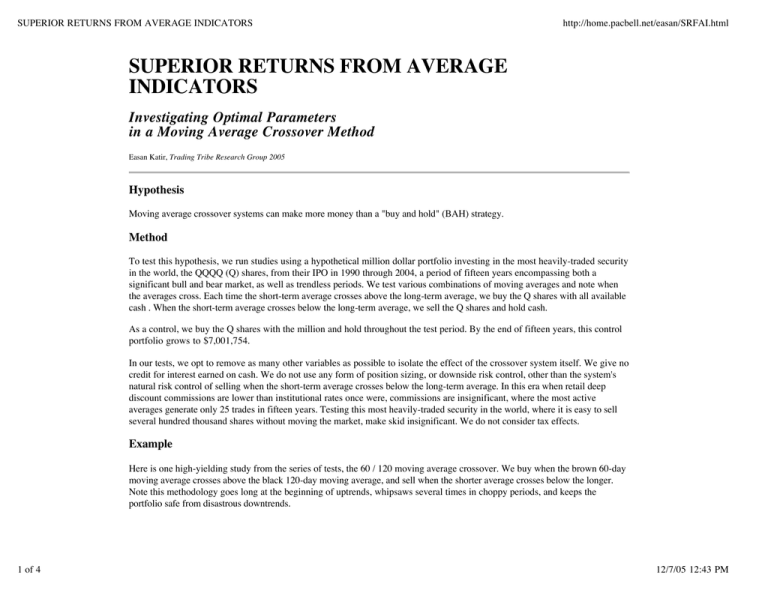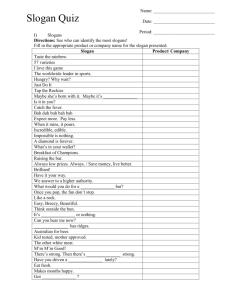SUPERIOR RETURNS FROM AVERAGE INDICATORS Investigating Optimal Parameters
advertisement

SUPERIOR RETURNS FROM AVERAGE INDICATORS http://home.pacbell.net/easan/SRFAI.html SUPERIOR RETURNS FROM AVERAGE INDICATORS Investigating Optimal Parameters in a Moving Average Crossover Method Easan Katir, Trading Tribe Research Group 2005 Hypothesis Moving average crossover systems can make more money than a "buy and hold" (BAH) strategy. Method To test this hypothesis, we run studies using a hypothetical million dollar portfolio investing in the most heavily-traded security in the world, the QQQQ (Q) shares, from their IPO in 1990 through 2004, a period of fifteen years encompassing both a significant bull and bear market, as well as trendless periods. We test various combinations of moving averages and note when the averages cross. Each time the short-term average crosses above the long-term average, we buy the Q shares with all available cash . When the short-term average crosses below the long-term average, we sell the Q shares and hold cash. As a control, we buy the Q shares with the million and hold throughout the test period. By the end of fifteen years, this control portfolio grows to $7,001,754. In our tests, we opt to remove as many other variables as possible to isolate the effect of the crossover system itself. We give no credit for interest earned on cash. We do not use any form of position sizing, or downside risk control, other than the system's natural risk control of selling when the short-term average crosses below the long-term average. In this era when retail deep discount commissions are lower than institutional rates once were, commissions are insignificant, where the most active averages generate only 25 trades in fifteen years. Testing this most heavily-traded security in the world, where it is easy to sell several hundred thousand shares without moving the market, make skid insignificant. We do not consider tax effects. Example Here is one high-yielding study from the series of tests, the 60 / 120 moving average crossover. We buy when the brown 60-day moving average crosses above the black 120-day moving average, and sell when the shorter average crosses below the longer. Note this methodology goes long at the beginning of uptrends, whipsaws several times in choppy periods, and keeps the portfolio safe from disastrous downtrends. 1 of 4 12/7/05 12:43 PM SUPERIOR RETURNS FROM AVERAGE INDICATORS http://home.pacbell.net/easan/SRFAI.html Results On the summary chart of test results below we see that a 10 day/120 day combination results in a net ending equity of $9.1 million, an encouraging result compared with the buy and hold control portfolio. As we run tests with longer averages, the outlook brightens even more. In fact, testing some of the longer combinations, the outlook becomes very bright indeed. Note the plateau on the matrix where the ending equity averages $16 million, over two times the BAH portfolio. Here are the results, in millions. Compare with the BAH strategy's return of $7 million. Long Average Short 120 2 of 4 160 200 240 12/7/05 12:43 PM SUPERIOR RETURNS FROM AVERAGE INDICATORS http://home.pacbell.net/easan/SRFAI.html Average 10 $9.1M $10.0M $12.9M $17.5M 20 $8.5M $10.7M $16.2M $15.9M 30 $8.5M $15.3M $15.1M $15.1M 40 $11.3M $16.4M $16.1M $14.5M 50 $16.1M $16.7M $15.5M $16.0M 60 $17.2M $16.0M $13.9M $15.0M Conclusion The application of moving averages to equities price data series helps the trader see trends greater than the daily fluctuations. All tested iterations of this moving average crossover method handily outperform a passive BAH strategy during the fifteen-year test period, a period which includes a great bull market, a devastating bear market, and trendless periods. All combinations produce profitable results. Some combinations produce significantly better returns than the BAH strategy. All tests produce a less volatile equity curve with smaller drawdowns than buying and holding for the period. Discussion The scope of this paper is to present broad brush results to illustrate a principle. Those who want their portfolio managed according to this method might investigate the details of drawdowns, the emotional quotient needed to stick with this discipline over the long term, position sizing algorithms, and the effect of various start-dates. The start date greatly affects results for the BAH investor. Many more bought near the top than at the beginning, and so missed much of the bull market, then lost capital in the bear market. The success of the BAH investment is highly start-date sensitive. The crossover system mitigates such sensitivity. It is prudent to have this rudimentary form of risk control in place to guard against catstrophic loss, as the BAH investor who watches equity climb to Everest-like heights only to lose 78% of it in the bear market might now agree. The author recommends investors seek a manager who is aware of this powerful method of risk control. If the reader anticipates trading on one's own, use some good charting software to step through each of these trades, imagine one's emotions at each important juncture along the way, and thus set one's expectations in a realistic way. In extended bear markets, this crossover method reveals another kind of compounding. After a bear market, a portfolio can buy more shares of the stock with the cash from the previous sale than if one only buys and holds. In this test, the BAH portfolio buys and holds 175,439 shares. As a result of this share compounding, the moving average method ends the test holding over 3 of 4 12/7/05 12:43 PM SUPERIOR RETURNS FROM AVERAGE INDICATORS http://home.pacbell.net/easan/SRFAI.html 400,000 shares. Bibliography, Sources & Acknowledgments Burke, Gibbons. "Crossing the Bar." Futures Magazine 1991 Covel, Michael W. Trend Following, FT Prentice Hall 2004 Murphy, John J. Technical Analysis of Futures Markets,New York Institute of Finance 1986 Seykota, Ed. The Trading Tribe. Bacon Press 2005 Sivadas, Iraja. mathematics professor, retired Trading Tribe research group, Incline Village, NV. Oct. 2004 - Mar. 2005. 1990-2004 QQQQ chart. Chart. TeleChart2000. http://www.tc2000.com. 2005. Wilder, J. Welles. New Concepts in Technical Trading Systems,Trend Research 1978 4 of 4 12/7/05 12:43 PM




